Raising Water Consciousness through
World’s Biggest Photo Exhibition and
Largest collection of Photo Stories on Water
Photo Stories | Water and Livelihood
Green Revolution in India and its Impact on Water Resources
Nandita Singh and Om Prakash Singh
15 January, 2018
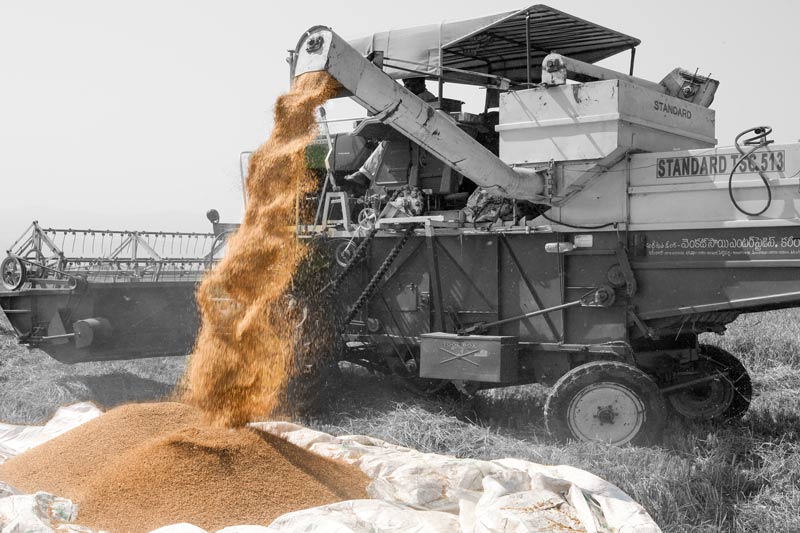
Starting in the 1960s, the ‘Green Revolution’ has transformed the face of Indian agriculture, having almost quadrupled the foodgrain production, in turn making the country self-sufficient as well as one of the largest exporters of foodgrain in the world. Water has been the undisputed driver of Green Revolution in India as elaborated in the story dated 20 December 2017. Without application of the right amount of irrigation water at the right time, these successes would not have been achieved despite availability of the other three essential components, namely, high-yielding varieties (HYVs) of seeds, chemical fertilizers and pesticides. However, this agricultural success has not come without a price. Both quantity as well as quality of water resources in the country has come to be seriously impacted as a result of Green Revolution. The cultivation of HYVs across the country has multiplied the irrigation demand as a result of which as much as 80% of India’s water resources stand diverted for irrigation. The canal irrigation networks developed and strengthened to support Green Revolution take the lion’s share from rivers and other surface water bodies, leading to drying up and disappearance of these sources. Further, failure or absence of canal irrigation has led to large-scale dependence on groundwater instead. Today more than 50% of the irrigated area depends on groundwater and in several districts it is more than 80%. According to Central Groundwater Board (CGWB), about 92% of the country’s ground water draft is used for irrigation. This has led to a situation where over 28% of the groundwater assessment units in the country have groundwater use substantially greater than the rate of recharge which is causing scarcity of water for drinking and other essential needs in the affected areas. Further, depleting water tables increase concentration of natural contaminants like arsenic and fluoride in the groundwater. In addition, intensive use of chemical fertilizers, pesticides and herbicides also degrade water quality. These chemicals easily leach down into the aquifers, making the groundwater unsafe for human consumption. Similarly, due to the practice of flood irrigation or precipitation, runoff from agricultural fields sown with HYVs tends to be rich in fertilizers and pesticides. This causes eutrophication of surface water bodies, destroys water ecosystems, besides poisoning surface drinking water sources. This photo story aims to illustrate how Green Revolution in India has affected the country’s water resources, in terms of quantity as well as quality. The title photo portrays a harvester reaping, threshing and winnowing rice crop in a paddy field in Chittoor district, Andhra Pradesh.
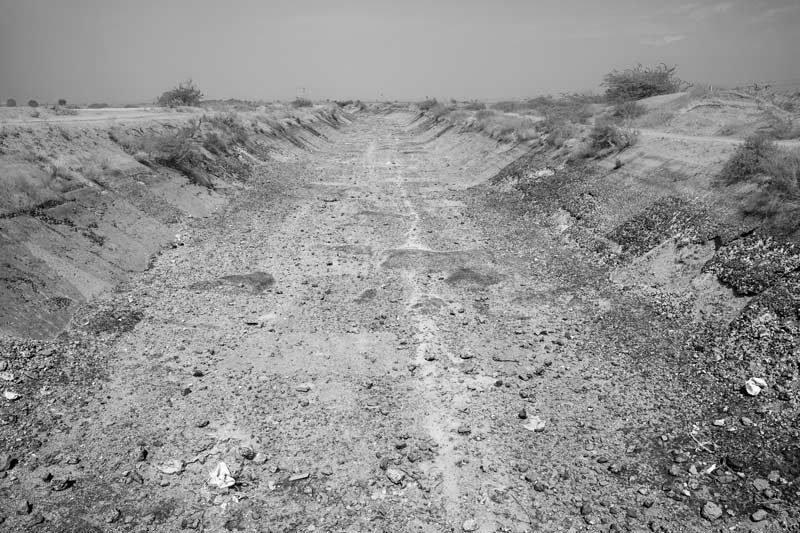
A dry irrigation canal in Anantapuramu district, Andhra Pradesh
About 60% of the foodgrain production in India comes from irrigated areas which in 2013-14 constituted 68.2 million hectares (mha), roughly one-third of the total cultivated area. In all, irrigation consumes as much as 84% of country’s total available water resources, including both surface- and groundwater. Surface water-based irrigation has been largely facilitated through canal irrigation networks originating from dams, barrages and major and medium irrigation projects which have been progressively constructed over the Green Revolution decades. However, in recent times, there has been substantial decline in the area under canal irrigation as these networks have turned inefficient in fulfilling the irrigation needs of the farmers. According to one estimate, between 1996–97 and 2002–03 the area under canal irrigation actually declined by 2.4 mha (13.8%). An important cause behind the decline has been inadequate water availability in the canals which in turn is a result of depletion of water in the feeder sources (primarily rivers) prompted by climate change impacts, increasing competition from other sectors like urban water supply, and loss of water from unlined canals due to seepage. All this affects the tail enders the most who often end up with dried up canals as the one shown in the above photo. This has, in turn, prompted a massive shift to groundwater-based irrigation.
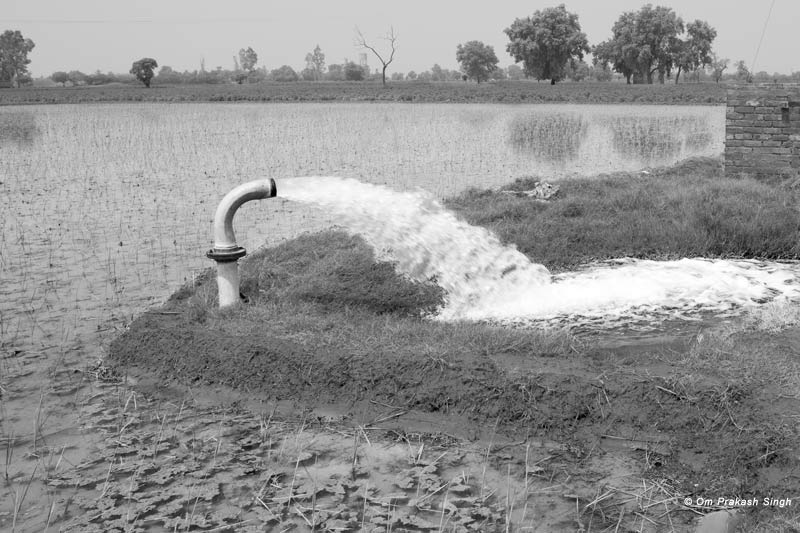
An electric tubewell withdrawing groundwater for irrigation of paddy fields in Mansa district, Punjab
The dependence of Indian agriculture on groundwater is very high, leading to an annual groundwater usage that is more than the combined usage by the United States and China. The share of groundwater in irrigation has increased from 28.7% in 1950-51 to a whopping 62.4% in 2012-13 and at present, over 42% irrigated area in the country is served by tubewells alone. Tubewells provide the farmer with benefits of timely water in required quantities irrespective of the agro-climatic setting, thereby providing higher reliability and irrigation efficiency up to 70–80% compared to mere 25-45% in canal irrigation. Moreover, farmers in even those areas which lack canal irrigation networks can enjoy the option of growing irrigated HYVs using groundwater. Tubewell irrigation has been supported by a government policy of free electricity in many states. However, on the darker side, indiscriminate pumping out of groundwater is causing rapid groundwater depletion. 839 groundwater assessment units in the country have been found to be ‘over-exploited’ and another 226 ‘critical’ where groundwater extraction is 100% or 90-100% respectively compared to the net annual groundwater availability. Punjab produces about 21% of wheat and 12% of the rice in India, for growing which the difference between the demand for water and its supply from different sources, is met through use of tubewells which contribute to as much as 75% of the state’s irrigation. As a result, large area of the state is reportedly facing the problem of depleting water table.
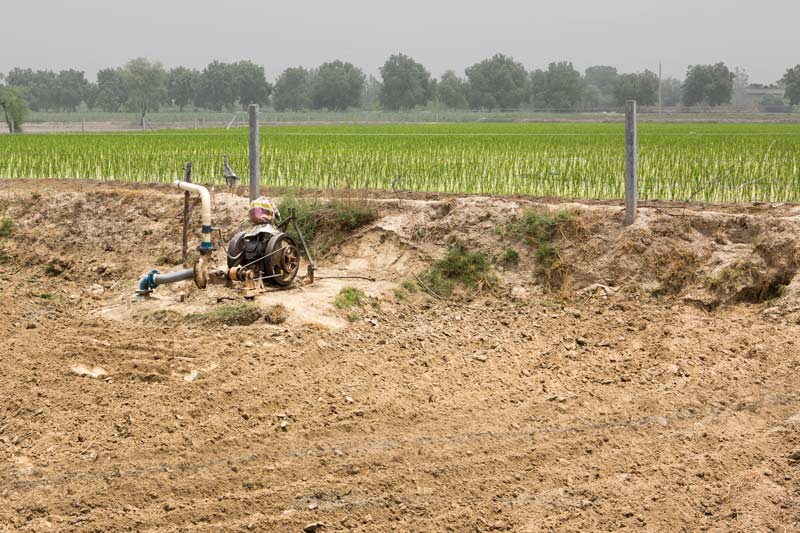
A tubewell used for raising paddy crop on desert soil in Fazilka district, Punjab
The HYV seeds have high adaptability to a variety of soil types, rainfall and temperature ranges. As a result, it has been possible to raise crop varieties that are not native to a region using the HYV seeds, as long as adequate irrigation, fertilizers and other necessary inputs are available. Consequently, paddy, which is neither a native plant, nor suited to the agro-climatic conditions of Punjab, has pushed out maize to make the state one of the largest producers of this crop. Fazilka district is an important producer of rice but the climate of the district is, on the whole, semi-arid and dry, and the soil here is largely ‘desert’ type. Rice is a tropical plant that requires sufficient water to grow well. To maintain the rice crops in the dry climate and desert soil, farmers indiscriminately use tubewells for irrigation as shown in the photo above.
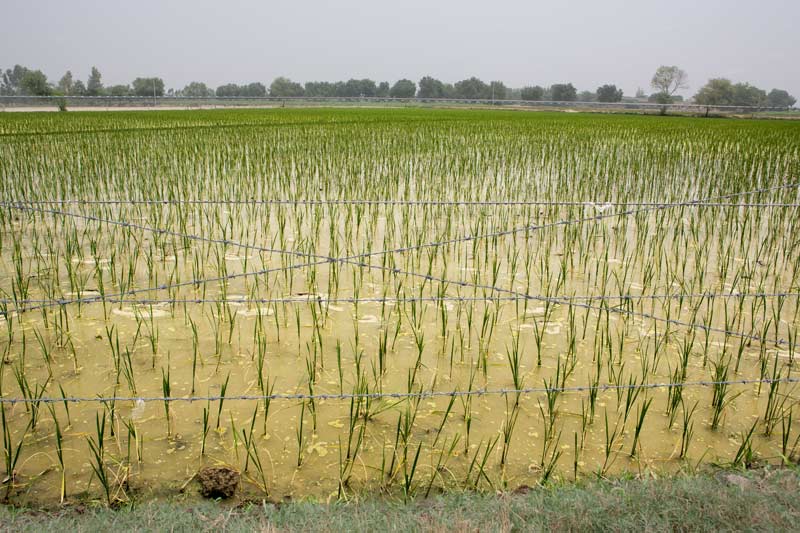
Transplanted paddy fields flooded using groundwater amidst desert soil in Fazilka district, Punjab
The trend of growing HYV seeds of food crops in agro-climatically unsuitable zones allows for wasteful use of valuable irrigation water as evident in the photo above. Since paddy needs to grow in flooded fields for a substantial part of the crop cycle, the soil used should have a good water holding capacity. Silt clay, silt clay loam, clay and riverine alluvial soil are thus considered as some of the best soil textures for rice farming. On the contrary, desert soil allows high permeability of the water applied. This implies that the water requirement for paddy crop in such soil becomes much higher than the estimated 3000-5000 litres ordinarily required for producing a kilogram of the grains. Thus growing of paddy in a district like Fazilka where the soil is sandy through tubewell-based irrigation is a highly wasteful practice.
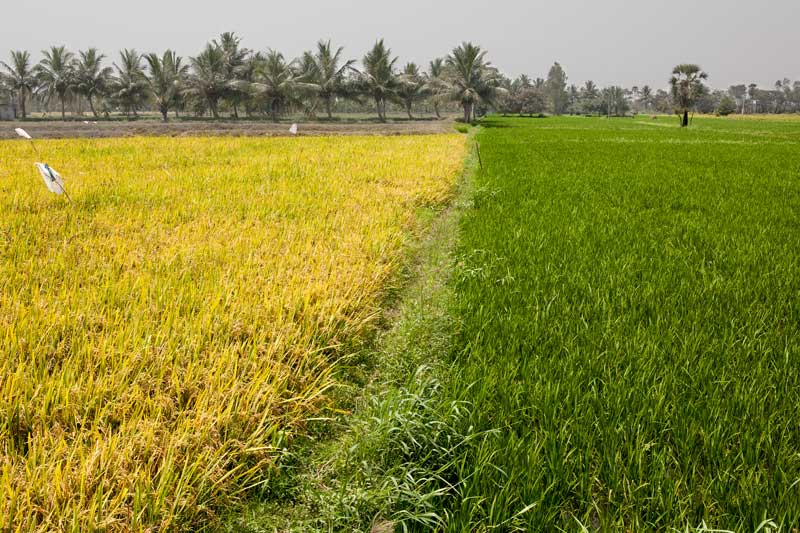
Paddy fields at different stages of cropping cycle in Nellore district, Andhra Pradesh
Apart from growing crop varieties unsuitable to the existing agro-climatic conditions, further drain on the valuable water resources, whether surface or groundwater, comes from multiple cropping of HYVs. Nellore district is a low rainfall area with average annual rainfall merely 889mm. Over 36% of the irrigation here is dependent on canal networks, but almost an equal area is irrigated by groundwater. Multiple cropping on the same plot or in the same area with crops at different stages of growth as in the above photo implies further pressure on the water resources as the intensity of cropping is high. Here three crops of rice are taken in a year primarily using groundwater.
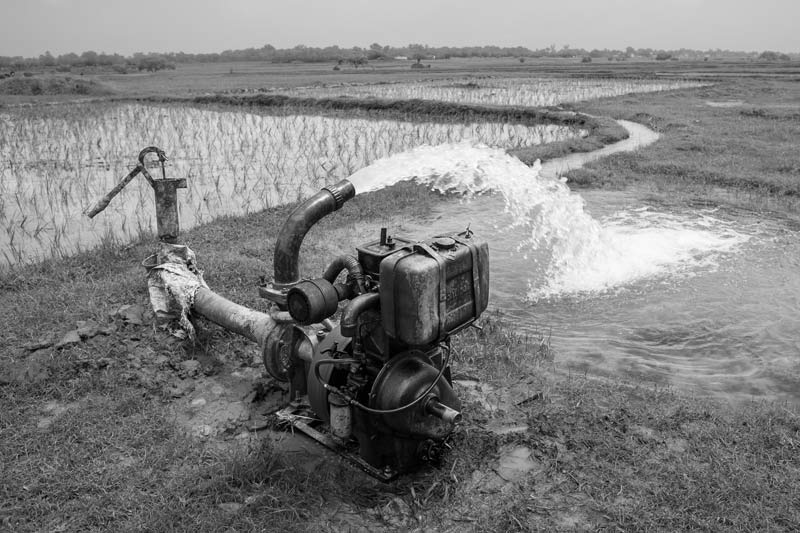
A diesel-run tubewell withdrawing groundwater for irrigating rice fields in Bhojpur district, Bihar
In Bihar around 49% of total area is irrigated but distribution of irrigation capacity is not even across the state. Only about 30% of total irrigated area is covered by canal networks, while nearly 63% of total created irrigation capacity in the State has tubewells as the source. Tubewell irrigation dependence is 75-85% in some of the areas, with rice-wheat cropping system occupying more than 70% of the gross cropped area in the state. A very high dependence of irrigation on tubewells, with dependence on diesel-run pumps due to lack of power infrastructure in rural areas has led to lowering of water table in a state where groundwater is claimed to be underutilized. In Bhojpur district, about 72% of the irrigated area is dependent on tubewells, with paddy as the major crop.
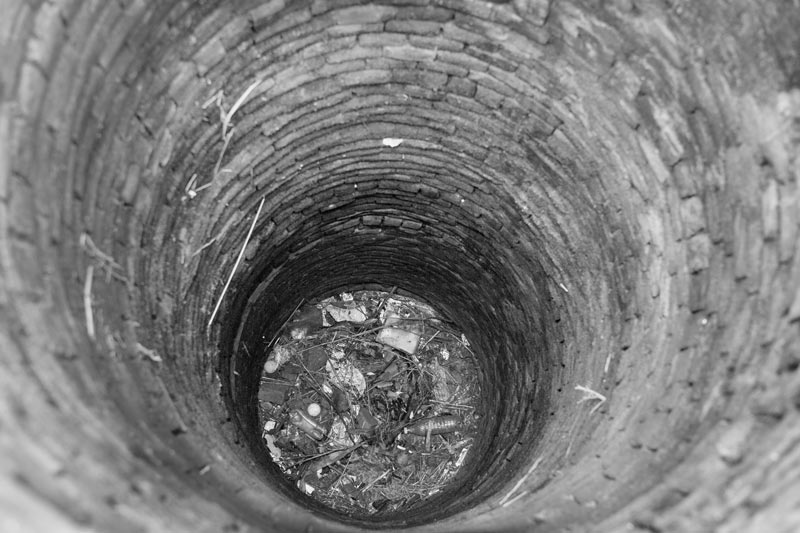
A drinking water well dried up due to overexploitation of groundwater for irrigation in a village in Patna district, Bihar
Overexploitation of groundwater for irrigation leads to rapidly declining water tables, which is ultimately resulting in drying up of wells as well as handpumps which are the main sources of drinking water in Indian villages. Further, in areas where grounwater contains naturally occuring contaminants such as fluoride and arsenic, lowering of water table has increased their concentration, leading to poisoning of groundwater-based drinking water sources. In Patna district, about 80% of the irrigated area is dependent on dugwells and tubewells, number of the latter being on the rise. In the southern, central and eastern parts of Patna district the water level has declined in recent years, presently being more than 10 meters below ground level (mbgl). This has led to drying up of a number of drinking water wells and handpumps that are shallow in depth.
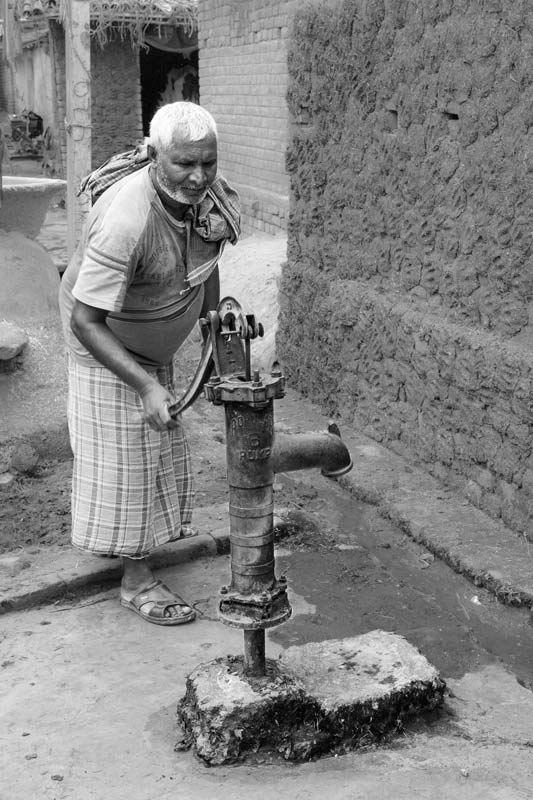
A dried up handpump due to overexploitation of groundwater for irrigation in Patna district, Bihar
In Bihar, not only are handpumps drying up as result of declining water tables, but even high concentrations of naturally occuring contaminants, particularly arsenic and fluoride, is increasingly reported. In Patna and 17 other districts, arsenic in handpump water is a serious problem, with concentrations much above the safe limit of 50 μg (as per Bureau of Indian Standards) and 10μg (as per World Health Organisation standards), exposing people to the health risk of arsenicosis.
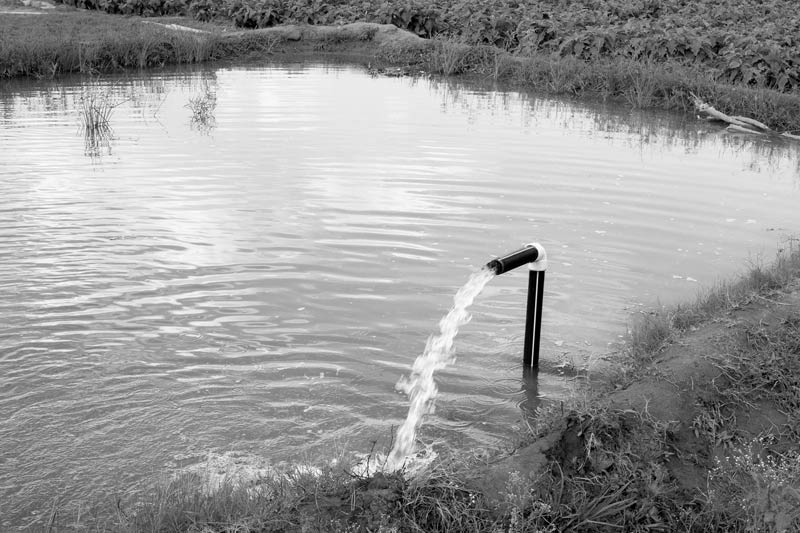
A tubewell extracting groundwater for irrigation in Kolar district, Karnataka
Karnataka is the eighth largest State in the country, with a climate that varies from very humid rainy monsoonal climate on the west to semi-arid warm dry climate on the east. There is a large variation in the rainfall with high rainfall at about 4000 mm in the west to as low as 500-600mm in the drought prone districts on the east. A number of major and medium irrigation projects provide canal irrigation along with minor irrigation through tanks, but dependence of irrigation on groundwater is high. As a result, 23% of the groundwater assessment units in the state are 'over-exploited', making it one of the nine states in the country where the groundwater levels had reached a critical stage. Kolar is a drought-prone district in the east with a semi-arid climate. Paddy is the most important irrigated crop here which is grown with 100% dependence on borewells. While the annual replenishable ground water resource in the district is only 59,063 hectare meters (ham), the annual groundwater draft, most of which is channelized for irrigation, is at the order of 1,15,323 ham. The groundwater development for the district is thus a whopping 175%.
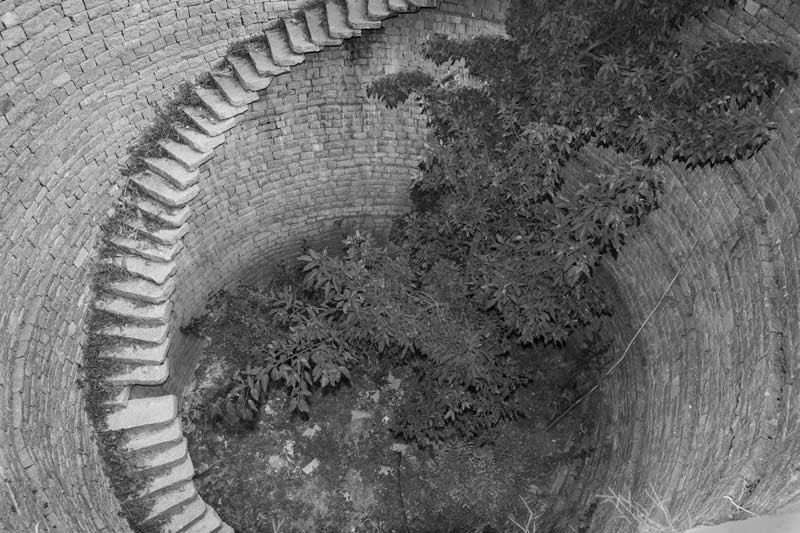
A dry irrigation well in Kolar district, Karnataka
Wherever dependence on borewells for irrigation has been high, the water table has receded drastically. It is estimated that between 1980 and 2012, groundwater levels have dropped sharply between 1 to 16 mbgl in India. This has affected water availability in not only drinking water wells but also in irrigation wells. Wells were the major source of irrigation in Kolar district but by 2011, 791 dug wells out of 11,196 had already gone dry in the district due to lowering of water level. One of these is shown in the above photo.
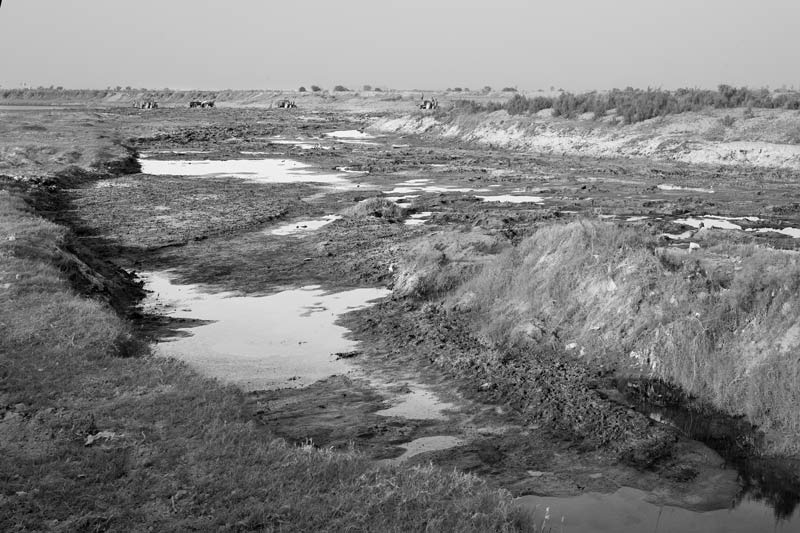
Dry Yamuna river bed in NOIDA, Gautam Buddha Nagar district, Uttar Pradesh
While groundwater-based irrigation reveals an extremely dark side for the country’s water resources as described above, surface-water based irrigation dependent on rivers and streams is no brighter. Diversion of large shares of river flows at dams and barrages for the major and medium irrigation projects, along with that for supporting drinking water supply systems in urban and rural areas, is depriving several rivers of the country of even the basic flow essential for maintaining their natural aquatic ecosystems. River Yamuna - the most important tributary of river Ganga - is one such glaring example. It is a 1,376 kilometres long river that originates from the Yamunotri glacier in Uttarakhand, and has a drainage system of 366,223 square kilometres - 40.2% of the entire Ganges Basin. Though a glacial river and supported by several tributaries, it is left with absolutely no water when it enters the territory of Delhi because after initial diversion for power generation, its water is completely diverted into Western Yamuna canal and Eastern Yamuna canal for irrigation at Hathnikund Barrage (old Tajewala Barrage) in Yamuna Nagar district of Haryana. Further downstream, just on the Delhi borders, whatever water is regained in the river is again tapped at Wazirabad barrage for drinking water supply to the city. As a result of these several diversions, Yamuna river bed remains dry for almost 9 months in a year at Delhi and in a number of stretches further downstream, one of which is shown in the photo above.
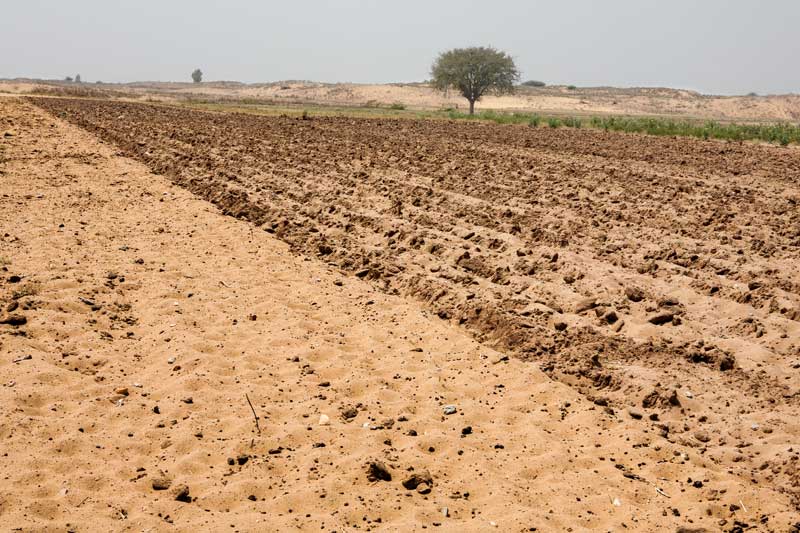
Desertification in Anantapuramu district, Andhra Pradesh
Rivers and other surface water bodies and groundwater are intricately related and in turn affect soil moisture. Progressive decrease in soil moisture renders the soil arid, leading towards desertification. When groundwater is overexploited, water table drops sharply and ultimately the soil moisture starts drying up. Simultaneously, surface water bodies connected to it also start drying on a more permanent basis. Similarly, when a surface water body dies due to over-abstraction of its water, the soil moisture build-up and the groundwater recharge facilitated by it halts. These two-way processes lead to progressive drying of the top soil layers. As presented in the previous photos, over-extraction of groundwater and overuse of surface water bodies for irrigation has been rampant in India. Further, overuse of chemical fertilizers degrades the soil texture and quality, reducing its water holding capacity. The net result is increasing aridification and ultimately desertification of agricultural land. Though any kind of soil may be affected in the above manner, semi-arid and arid areas are more susceptible. According to a recent assessment from Indian Space Research Organization (ISRO), more than a quarter of India’s land is turning into desert, with increase in the rate of degradation of agricultural areas. In as many as eight states around 40-70% of land has undergone desertification. Moreover, during the last 10 years period, 26 states have reported an increase in the area undergoing desertification. In Andhra Pradesh over 14% of the total geographical area is observed to be under desertification. The above photo shows a segment in the state where over-abstraction of groundwater for irrigation is leading to conversion of agricultural land into dry sandy soil.
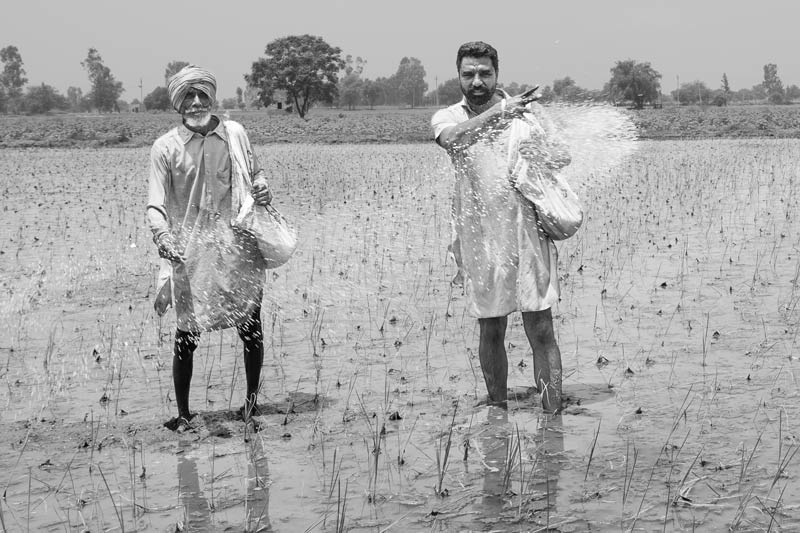
Fertilizer being applied in a paddy field in Mansa district, Punjab
As a part of the Green Revolution, the second most important input for enhancing productivity of HYV crops (after irrigation) is chemical fertilizer. Fertilizers enhance productivity by adding nitrogen, phosphorous and potassium to the soil. The consumption of chemical fertilizers in India has increased from 65.6 thousand tonnes in 1950-51 to 26.75 million tonnes in 2015-16. There are large disparities in the state-wise consumption of fertilizers with Punjab being ranked as number one with respect to its per-hectare use. In Punjab this figure is 223.46 kg per-hectare as compared to 90 kg per-hectare nationally, and both rice and wheat - the top foodcrops of the state - are grown with heavy input of fertilizers as shown in the photo above.
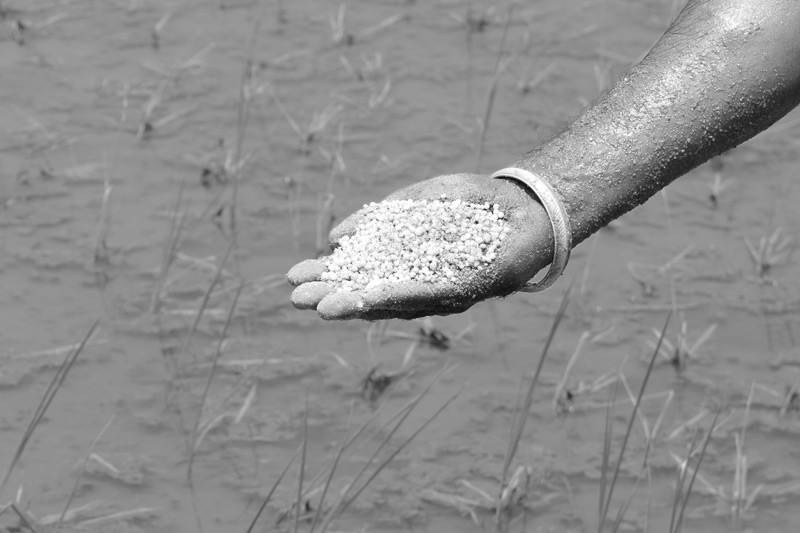
A handful of fertilizer to be spread in a paddy field in Mansa district, Punjab
In the South-western part of Punjab – called Malwa region, where the soil quality is poor, use of fertilizers for improving soil fertility has been especially high. However, a large part of the fertilizers applied to the crop remains unutilized and is either leached into groundwater aquifers or washed off into the field run-off, ultimately reaching surface water bodies. High nitrate concentration in water has negative implications for human as well as ecosystem health. According to a Greenpeace study from 2009, conducted in farms across the Malwa region, most wells were contaminated with nitrates, and 20 percent of all sampled wells had nitrate levels above the safety limit of 50 mg per litre as established by World Health Organisation (WHO). This nitrate pollution in the groundwater was seen as clearly linked with excessive use of synthetic nitrogen fertilizers in the fields.
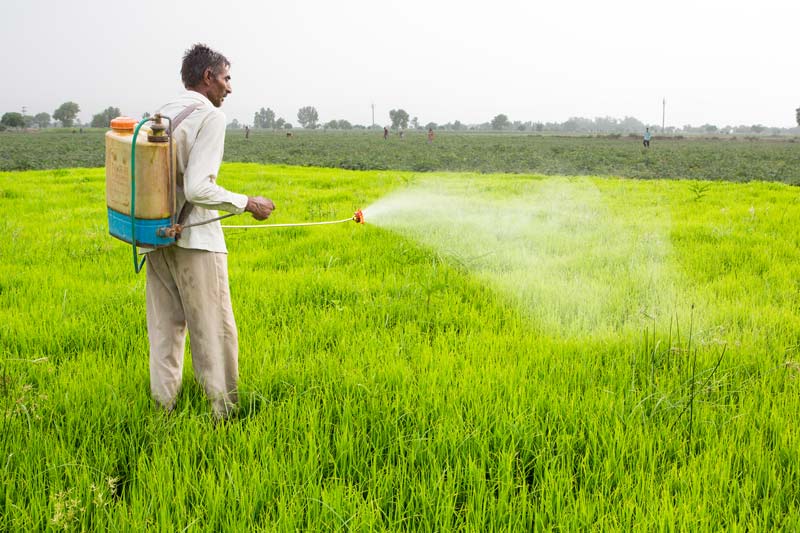
Pesticide being sprayed in a paddy field in Fazilka district, Punjab
The term pesticide covers a wide range of compounds including insecticides, fungicides, herbicides, rodenticides, molluscicides and nematicides, which have been commonly used in Green Revolution for enhancing crop productivity. However, the use of pesticides is known to seriously affect environment as a significant portion of the applied chemical actually enters water through surface runoff or through leaching, ending up in ponds, lakes, rivers, etc. and in groundwater aquifers. From there consumption of contaminated water affects the health of flora, fauna and human beings. Many pesticides belong to a category of toxic chemicals called ‘Persistent Organic Pollutants’ (POPs) - that last in the environment and circulate globally for several years before breaking down, and are hazardous for health and known to be even carcinogenic. In India, Uttar Pradesh, Maharashtra, Andhra Pradesh, Punjab and Haryana are the states that account for 70% of the national pesticide consumption. In terms of intensity of use, Punjab holds the second position in the country, with overall application of 400kg per ha as against 150kg per ha in India. Paddy and wheat are the two most important food crops for the protection of which pesticides are used in the state.
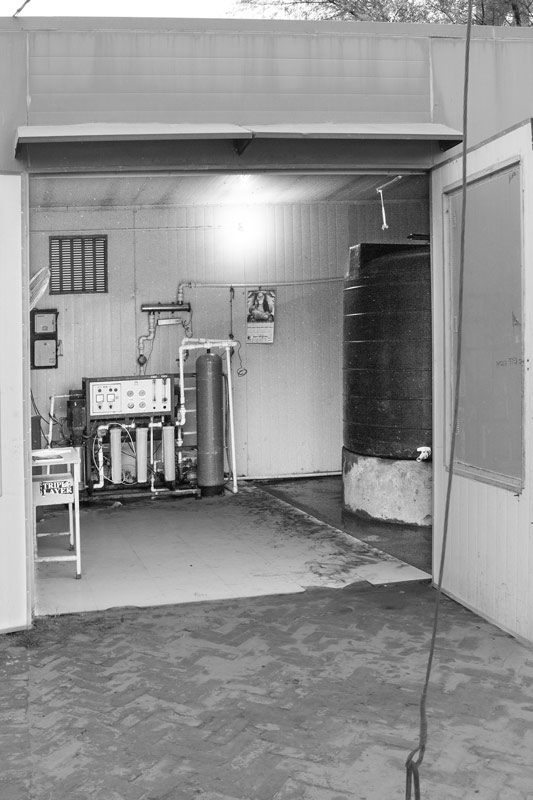
A Reverse Osmosis (RO) plant for treating local groundwater for drinking in a village in Bathinda district, Punjab
Groundwater contamination due to indiscriminate application of fertilizers and pesticides in the agricultural fields is emerging as a serious threat in a number of Green Revolution states, Punjab being on the forefront. The Malwa region of Punjab is particularly affected where consumption of pesticides is estimated to be over 75% of the total used in the whole state. As a result, groundwater in the region has high concentrations of salinity, nitrate and POPs. Contaminated groundwater is a major cause of cancer and other serious health problems in the region. Cancer is mostly found in four districts of Malwa namely Mansa, Mukstar, Faridkot and Bathinda. In order to safeguard public health, RO plants are being installed in all affected villages so that safe drinking water can be made available to the public, as shown in the above photo.

Procuring safe drinking water from a RO plant in Bathinda district, Punjab
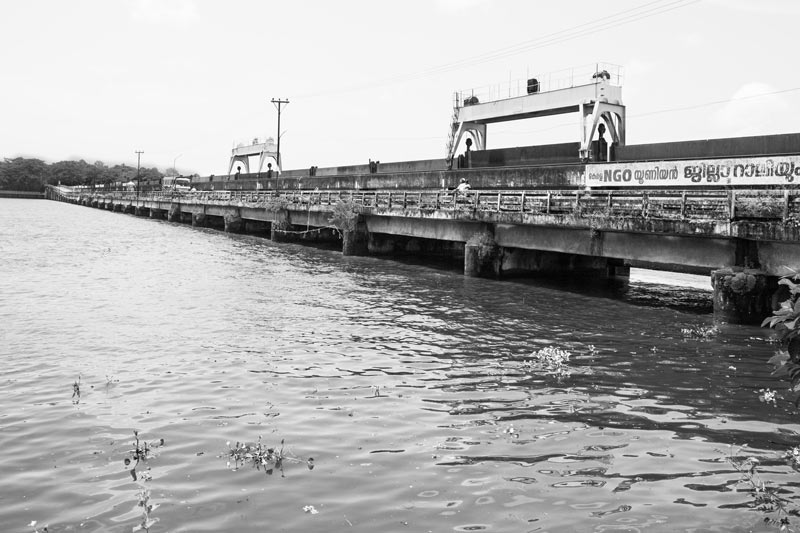
Thanneermukkom Salt Water Barrier separating freshwater of Vembanad lake from saline water of the Arabian Sea in Alappuzha district, Kerala
Kuttanad - a wetland drained by rivers Pamba, Achencoil, Manimala and Meenachil - has developed as the ‘rice bowl’ of Kerala after introduction of Green Revolution. Primarily constituting the districts of Alappuzha and Kottayam, it lies at a depth of 0.6 to 2.2 m below mean sea level (MSL). Here paddy is largely grown in fields reclaimed from the Vembanad Lake and the floodplain marshes of the four rivers. The Lake used to receive freshwater from the rivers draining into it during monsoons which helped flush out agricultural pollutants from the fields. During the dry season between November and June however, saltwater inflow occurred from the Arabian Sea, which prevented farmers from taking a second paddy crop. In order to prevent intrusion of saltwater into Kuttanad lowlands, the Thanneermukkom Saltwater Barrier was constructed in 1975, dividing the Lake into a brackish water northern part and a freshwater-based southern part (in Kuttanad) fed by the rivers draining into the lake. Construction of the Barrier has facilitated Green Revolution in Kuttanad by enabling the farmers’ access to freshwater during the dry season for irrigating an additional paddy crop. However, according to Dr K.G. Padmakumar, Director of International Research and Training Centre for Below Sea-level Farming in Kuttanad, it has adversely affected the lake's water quality since the fertilizers and pesticides used for agriculture can no longer be flushed out. Also, the livelihoods of fishermen in the area is affected. The marine fish and prawns that reproduce in saline waters of sea and move to the lake afterwards can no longer migrate, while breeding of the estuarine species is no longer possible because these require a small amount of salt water for the purpose.
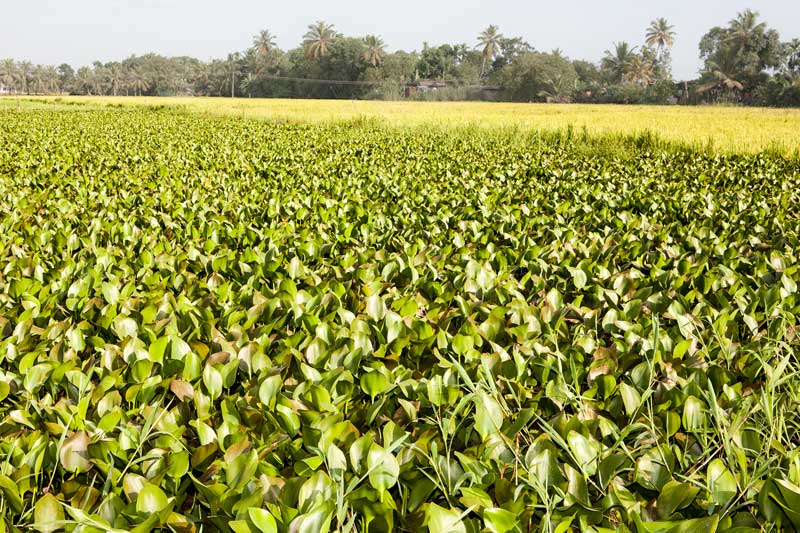
Eutrophication in wetlands of Kuttanad in Alappuzha district, Kerala
Excessive use of fertilizers leads to leakage of nutrients, particularly nitrogen and phosphorous, causing eutrophication. One important result of the process is increased growth of microscopic floating plants - algae, and the formation of dense mats of larger floating plants such as water hyacinths. This process increases the biomass load, ultimately causing oxygen depletion in the water, seriously affecting the naturally occurring flora and fauna. In many rivers and lakes in India, eutrophication is a common problem, run off from fertilizers used in agricultural fields being a major culprit. Water hyacinth is a weed that is widespread across surface water bodies in India affected by eutrophication. Kuttanad is also exposed to this problem. While there is no doubt that the Thanneermukkom Salt Water Barrier has helped boost agriculture in the region, it is leading to eutrophication in Vembanad Lake and Kuttanad region. After the launch of Green Revolution, heavy loads of pesticides and fertilisers started being added for enhancing rice production. Before the Salt Water Barrier was constructed, the monsoon flooding and later tidal inflow helped flush the water body annually, cleansing the water and the soil of these contaminants. However, now the drained water from the rice fields containing the nutrients and contaminants remains stagnant, leading to rampant propagation of the water hyacinth in the waters.
This photo story has illustrated how Green Revolution in India has impacted the water resources of the country. Large-scale adoption of irrigated cultivation of HYVs, most importantly rice and wheat which are highly water-intensive, has caused increasing demand on the country’s water resources. The reducing efficiency of irrigation canal networks or their absence altogether has prompted an exponential increase in dependence on tubewells, which is leading to rapid groundwater depletion in many areas, notably in the semi-arid and arid zones. The rapidly dropping water tables have caused drying up of shallow irrigation wells, drinking water wells and even handpumps, also adversely affecting local ecosystems, causing aridification. Also, lowered water tables have increased the concentration of naturally occurring contaminants in groundwater, such as fluoride and arsenic, which poison groundwater-based drinking water sources. Further, abstraction of huge amounts of water from rivers for feeding the canal irrigation networks created for supporting Green Revolution itself is causing death of rivers. In addition, intensive use of fertilizers and agrochemicals has ended up polluting surface and groundwater sources. Nitrate is an important pollutant in groundwater and surface water sources resulting from application of chemical fertilizers which causes serious health problems and also destroys water ecosystems through eutrophication. Pesticides, classified as ‘Persistent Organic Pollutants’ (POPs) that last in environment and circulate globally for several years before breaking down, and known for their negative health impacts including cancer, have been found in water samples from aquifers as well as rivers in India, again sourced primarily from agricultural fields.
The above impacts of Green Revolution on India’s water resources have far reaching implications for human populations as well as nature. Diminishing groundwater reserves and dried up rivers and other surface water bodies reduces water availability for drinking and other domestic uses, depriving women, men and children living in local communities of their access to adequate water for drinking and other personal uses. Similarly, contaminated surface- and groundwater deprives people of access to safe water, exposing them to serious health risks. These effects interfere with enjoyment by women, men and children of their human rights to water as well as concomitant rights such as health, education, livelihoods and development. Depreciated quantity as well as degraded quality of water resources further deprives local ecosystems of their vitality, causes loss of valuable biodiversity and significant microclimatic changes, further thwarting sustainable environment and ultimately sustainable development. Water is the basis of life. Without access to adequate and safe water human beings as well as flora and fauna cannot survive. Moreover, water is a basic resource for sustaining livelihoods, industry and other developmental needs. Water resources of the country cannot be allowed to be diverted and degraded for the purposes of Green Revolution alone. There is thus an urgent need to look for sustainable alternatives for upholding the achievements of Green Revolution in India without further compromising on the quantity and quality of the water resources. There is need to define a way forward where water sustainability and sustainable agriculture can go hand-in-hand so that the successes of Green Revolution can continue to be achieved.